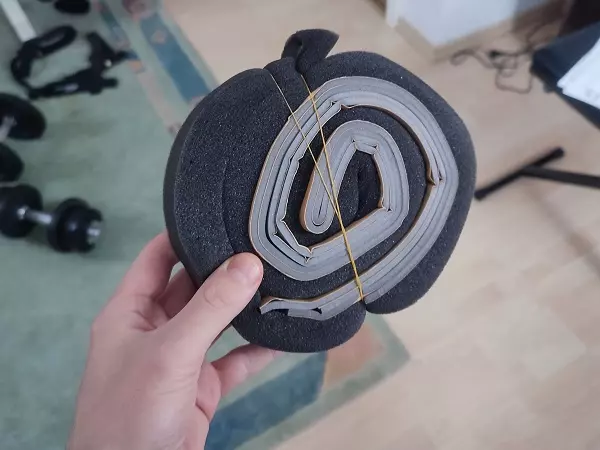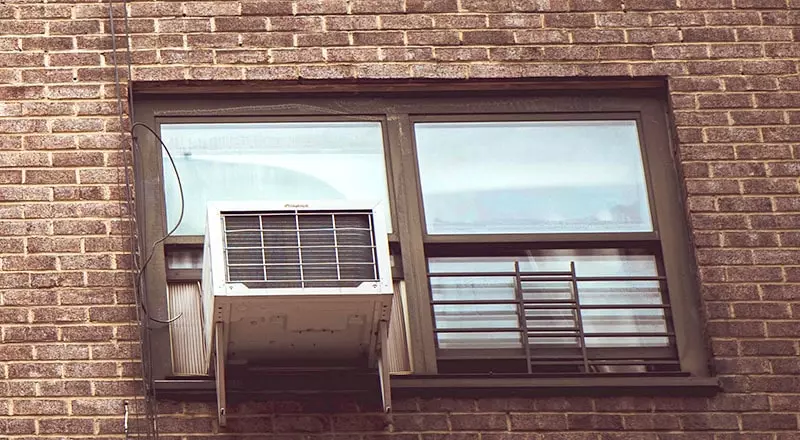How can you insulate a window air conditioner? Usually, the window kit that comes with a window AC does not fit perfectly and leaves room for heat to enter your room.
So, let’s have a look at some improvements you can make to improve your window AC’s insulation (and, therefore, its cost-efficiency)!
Quick answer: You can add insulation around a window AC by gluing styrofoam panels around the sides. To close all air gaps, use spray foam or foam tape. If available, close your outdoor shutters to reduce the amount of heat entering your room.
In this article, we’re going to check three different kinds of insulation:
- Insulation around the window AC (side panels, air gaps between window and window AC)
- Insulation inside the window AC
- Insulation outside the window AC (the window glass itself)
Let’s have a look at all the different ways to improve your window ACs insulation!
How to insulate a Window AC for better efficiency
Window ACs usually come with a window kit for installation. The purpose of the window kit is to cover the open area around your window AC.
However, these window kits are usually made of cheap plastic. So, they don’t insulate well.
And on top of that, they are one-size-fits-all (with moveable parts) to fit your window. Likely they don’t fit your window perfectly and (small) air gaps remain.
Here are the steps to maximize your window AC’s insulation:
#1 Add styrofoam panels around the window AC
A lot of outdoor heat enters your room by penetrating the thin plastic window kit. So, that’s where we start insulating.
The most straightforward insulation is to just stick styrofoam panels to the window kit.
Styrofoam is a very good insulator. And it is cheap.
Before sticking it to the window kit (around the window AC), you should measure the dimensions of the side panels of your window kit.
Then, you can cut the styrofoam panels to this exact size.
You could even get a large-size styrofoam panel and cut out a rectangle matching the dimensions of your window AC in the middle of it.
Then, you won’t have to deal with separate styrofoam panels. Instead, you have one large piece that fits your window AC.
However, that’s only a design choice. Insulation-wise it does not really make a significant difference.
To glue the styrofoam panels to your window kit you can use either a specific styrofoam glue or any regular white glue you already have at home.
( Styrofoam is not heavy, so you don’t need strong glue )
#2 Insulate air gaps around the AC using spray foam
Now that you’ve covered the side panels of your AC’s window kit with styrofoam, let’s close the remaining gaps.
Spray foam is ideal for covering any holes and gaps around the window AC’s sides.
Spray foam has three advantages that make it very well-suited for window AC insulation:
- It insulates well
- You can fill very narrow gaps using the spray foam’s supplied spray tube
- Spray foam expands and fits any space perfectly without exerting pressure
These advantages make it very well-suited for thick windows, or windows sitting in a thick frame.
Spray foam is great for insulating volume.
If instead, your window and its frame are very thin, a layer of HVAC tape would also do the job.
#3 Use foam tape for insulation
Most window ACs come with accompanying foam tape. Foam tape is a kind of tape that has foam attached to the non-sticking side.
If you don’t have one already, get this weatherstrip tape(click here to view it on amazon).
You can use foam tape to insulate the sides around your window AC, as well as below the window.
Since foam tape is designed to stick to plastic surfaces, it is also well-suited to insulate gaps anywhere in the side panels of the window kit.
The best advantage of foam tape when you compare it to the other insulation methods is that it’s very subtle.
And it does not look like it’s do-it-yourself insulation such as spray foam or styrofoam panels.
Additionally, foam tape requires little installation work. It’s just taping something, with no skills involved.

#4 Close outdoor shutters to minimize heat entering
If you have shutters located on the outdoor side of your house, close them until they reach the window AC.
Shutters will block off a large part of the heat.
Since they are located outdoors, they will block off the heat before it reaches the inside of your room.
This shutter insulation does not work for shutters located inside your room! In this case could even increase your room temperature, since they absorb sun rays. This is a process that converts light to heat.
On very hot days, just closing your shutters will reduce your window AC’s power consumption.
And it requires no installation work.
#5 Insulate internal ducts with HVAC tape
HVAC tape (click here to see it on amazon) is a special metal-coated tape that is used for sealing air gaps in HVAC systems.
Also, HVAC tape is used to insulate hot (or cold) ducts.
You can use HVAC tape to close any cracks in your window AC’s case. Especially, if your window AC is old and worn out, closing cracks and gaps directly on the window AC will make a difference.
Note that HVAC tape is not for closing gaps between your window and the window AC.
It is only for closing cracks in the window AC itself!
You can also open your window AC and add insulation to the internal ducts using the HVAC tape.
Here’s how you can add insulation to your window AC ducts:
- Leave the window AC running for a few minutes
- Turn it off and feel which ducts are warm
- Insulate the hot ducts using HVAC tape
#5 Add window insulation foil to your window
Window insulation foil is an insulating foil that you can stick to your window. It lowers the amount of heat penetrating your window.
So, it’s a kind of insulation that does not directly affect your window AC, but rather the area surrounding it (the window itself).
Window insulation foil is not really necessary. But if you want to maximize your window AC’s efficiency, then you can consider it.
Window insulation foil usually diffuses the light, so your window won’t be clear after installing the insulating foil.
That’s why I don’t recommend it for rooms you spend a lot of time in. The enjoyment of having a clear window is worth more than the efficiency improvement you get.
Conclusion
Of all the types of insulation, we looked at, sealing the gaps around the sides of your window AC will make the biggest efficiency difference.
So, closing the gaps using foam tape or spray foam should be your priority.
The other insulation methods are just a bonus for maximum efficiency!
